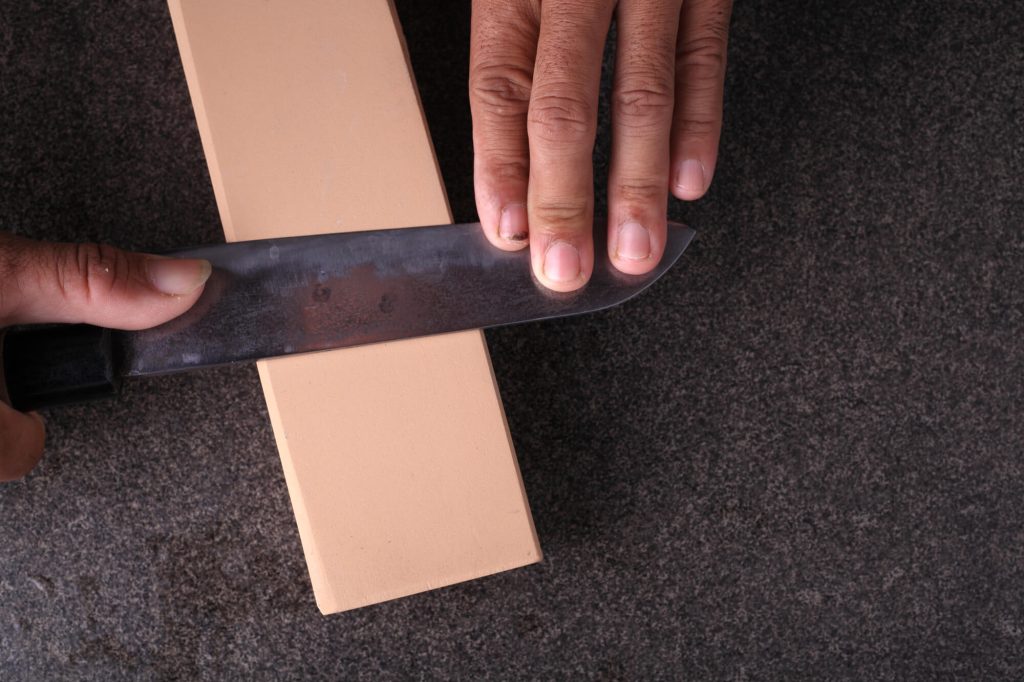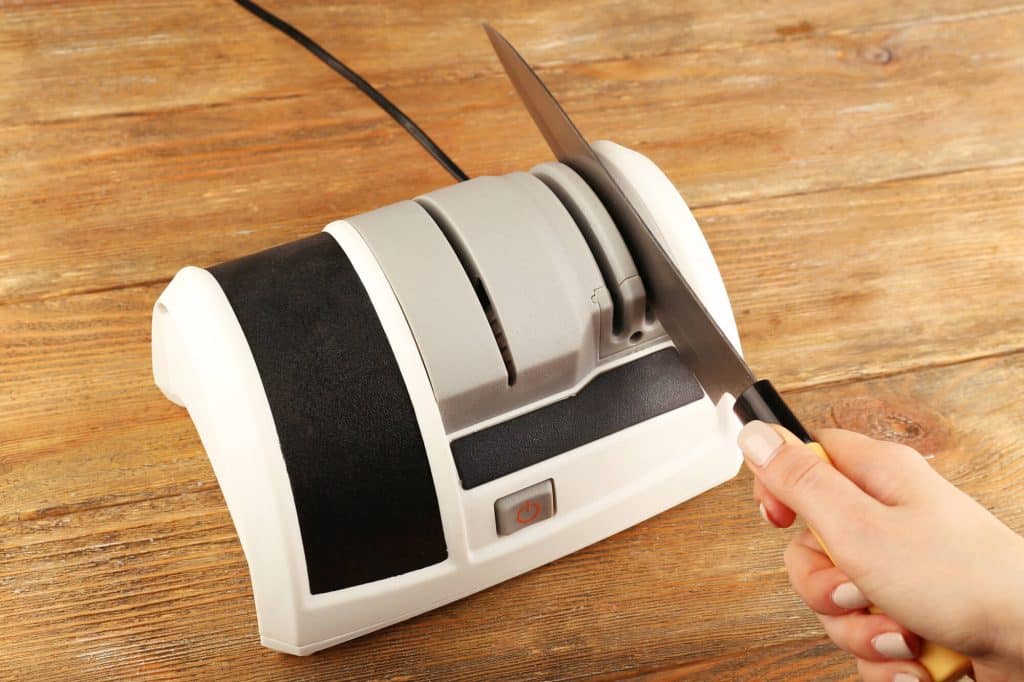Santoku knives are built to have a thin, brittle, and sharp blade. To make sure the knife performs smoothly and efficiently, the blades must be kept sharp. A santoku blade usually consists of high-carbon steel.
So you need to be very careful while sharpening it and know the techniques thoroughly.
When To Sharpen Santoku Knife?
Santoku knives should be sharpened once or twice a year for casual use and once a month for professional use. And you should sharpen it a few times a year for general use at home. The condition of the blade gives you the sign when to sharpen the knife. The most important thing to look out for is missing burrs on the edge and the dullness of the blade. You can simply run your finger over the edge to test the sharpness and check if it’s required to sharpen the knife.
Since most Santoku knives have a sharpened edge on one side and are made from high carbon steel, whetstones are usually recommended to sharpen the Santoku knives. Santoku knives are also easier to sharpen since they do not have a bolster and are usually only sharpened on one edge. Santoku knives usually come sharpened to an angle of 10 – 15 degrees out of the box.
Sharpening Santoku knife with a whetstone

The most effective way to sharpen a Santoku knife is to use a whetstone. Whetstones are fine-grained stones used for sharpening the edges of cutting tools. The term “whet” means “to sharpen”. Whetstones usually have two sides with separate grit: one is the coarse side and the other one is the finer side.
Using a whetstone gives more flexibility to sharpen knife edges as you can manually sharpen different parts of the knife as you please. So it works for both single and double-beveled knives. This is the general process for sharpening a Santoku knife with a whetstone but don’t forget to read the specific instructions that come with the whetstone you buy:
- Put the whetstone under water and let it soak.
- Use the coarse side first, tilt the knife at approximately 45 degrees with the stone borders and pin the knife edge on the coarse side maintaining the angle the knife came with.
- Run the knife towards you covering the whole blade in a smooth motion.
- Reverse the process in the same way in a backward fashion.
- Continue running the knife up and down the stone until you see a burr on the edge.
- Repeat the process on the other side of the knife has a double bevel.
- Use the finer side of the stone and repeat the whole process.
- Thoroughly wash and dry the knife.
Can you sharpen the Santoku knife with an electric sharpener?

Electric knife sharpeners are fast and convenient alternatives to whetstones offering many sharpening options for different kinds of blades. The downside is they can only be used in some specific settings and don’t provide much flexibility. They are also quite expensive and they tend to lack subtlety. While you can sharpen double-beveled Santoku knives with electric sharpeners, it is best not to use them on Santoku knives. Also, you cannot use an electric knife sharpener on a Japanese chef knife with a single bevel edge.
Japanese knives are built with durable yet thinner steel. They’re shorter and more delicate than their Western counterparts Chef’s knives. Many of them come with something called a Granton edge. It’s very sharp and doesn’t let the food stick to the blade of the knife. Electric sharpeners can easily damage a Granton edge. So subtlety of the knife can get lost while sharpening it with an electric sharpener.
But then again, an electric sharpener can still provide an easier and faster way to sharpen Santoku knives provided that they have double bevel edges.
Sharpening Santoku knife at home
You can use both whetstone or electric knife sharpener to sharpen Santoku knives at home. It is best to use whetstone for sharpening them as it gives you lots of versatility. And it doesn’t need any power source or anything. Once you get used to using it, it won’t be uncomfortable for you to use.
But if you don’t feel comfortable with a whetstone and your knife is double beveled and you just an easy and fast solution for sharpening your knife, feel free to use an electric sharpener to keep your knife smooth and running. Beginners also can use the electric sharpener before they can use the whetstone.
Benefits of sharpening knife
Sharpening your Santoku knife is essential for keeping its blade quality as good as new. It’ll take very little effort for you to make cuts and make your cutting process very fast. It’ll also help you make precise cuts. A chef must be in a good mood for their dishes to be delicious. A properly sharpened knife can undoubtedly keep the chef in a happy mood.
On the contrary, having a dull blade means that whatever you do, you’ll only be wasting your time and energy. The cuts will still be bad for double the effort and it’ll also take double or triple the time. Sometimes fine cuts are essential while cooking food. In those cases, dull blades can ruin the whole dish. But that’ll only leave the chef unsatisfied.
Sharpening knives is also a great thing for people who have a passion for cooking. While sharpening their knives, they truly get to understand the nature of their knives. And this later helps their dishes get even better.
Sharpening knives yourself helps save your money too. It helps the knives last a lot longer, so you don’t have to buy new ones often. And also you don’t have to send your knife to the shop once in a while for repair either.
Another advantage you get from sharpening your knife is that you’re prolonging its life. It also helps reduce the chances of slippage and accidental cuts to your hands. And it’s because sharp knives are predictable. But dull blades aren’t. A dull blade can slip or slide and increase the risk of injuring your hands.
Final thoughts
While you can use an electric sharpener to sharpen your Santoku knife with a double bevel edge, whetstone might be a better option for you unless you’re a beginner. Electric sharpeners aren’t suited for use on the single-bevel Santoku knives either. So overall, whetstone is the more flexible choice.
Sharpening your Santoku knife is not only doing a favor to the knife itself but also to you. Taking proper care of the kitchen tools greatly enhances your whole cooking experience. So keep it in mind to sharpen your knife whenever the blade starts showing signs.